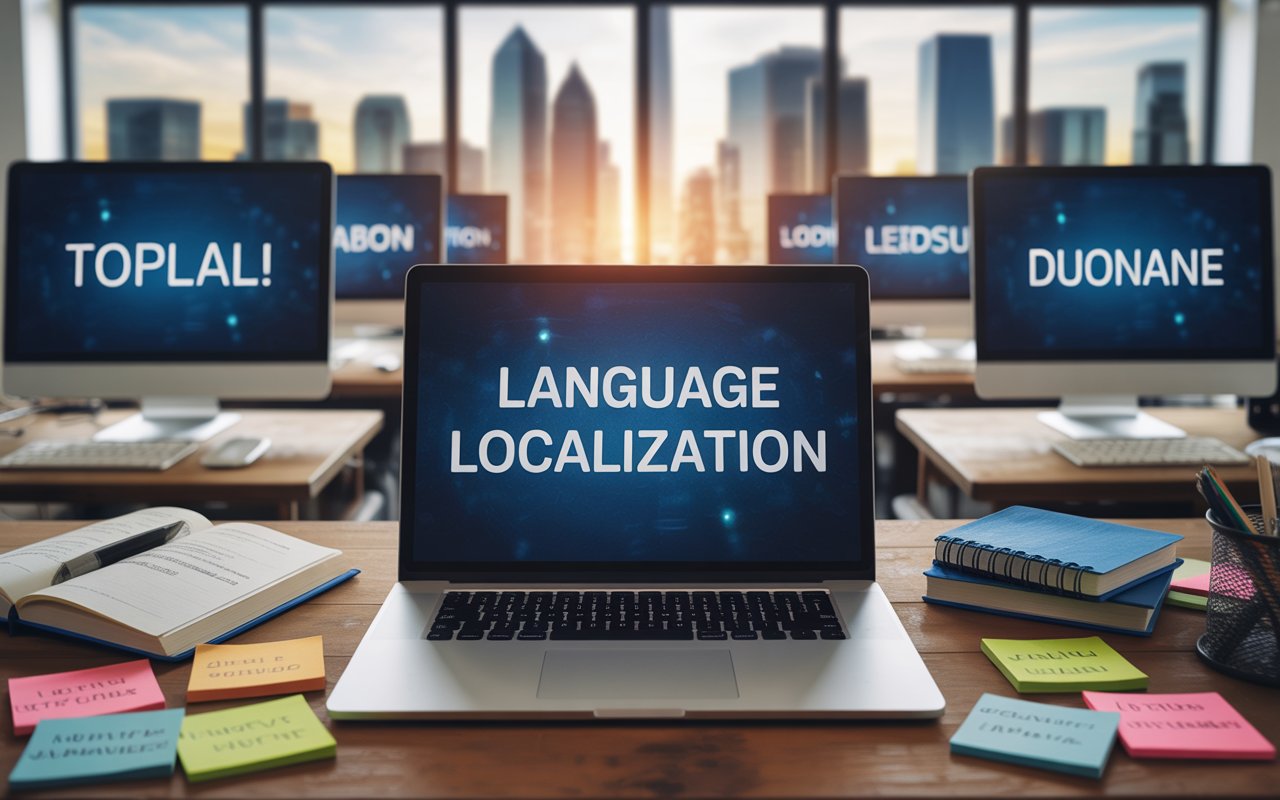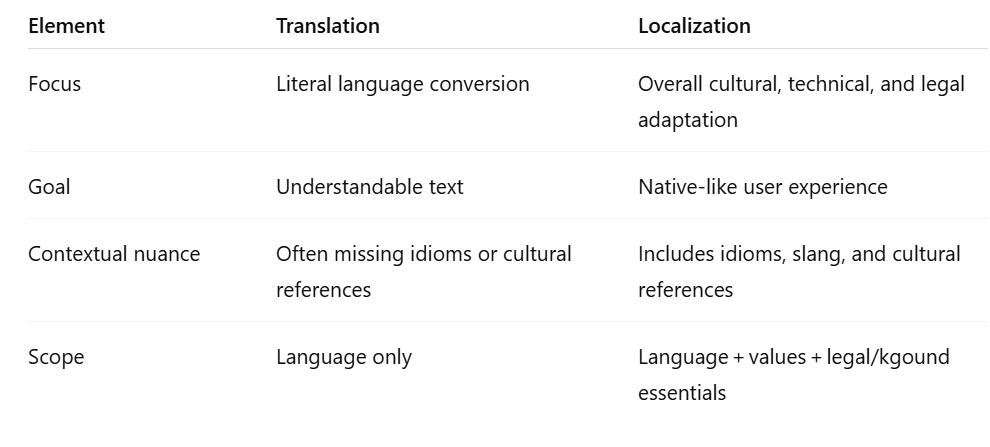
What Are Localization Services and How Do They Help Global Businesses?
Have you ever stopped using a website, app, or game because it felt strange? It might have used slang you didn't understand or talked about ideas you weren't familiar with. That's when localization comes in. What are localization services really, and why are they so important for businesses that want to do well around the world?
Localization changes content not only in language but also in culture and what users expect. When done right, users will feel like the product was made just for them. Want to know how this powerful approach helps businesses all over the world connect with people on a deeper level? Stay with us; you're about to learn some important things!
Understanding Localization Services
What are localizations, exactly? At its core, localization goes beyond translation. It includes:
- Language adaptation: not just translating words, but choosing local idioms, grammar styles, date formats, currencies.
- Cultural nuance: tweaking imagery, humor, tone, colors, icons so they resonate culturally — for instance, changing red imagery for Chinese New Year or swapping idioms (e.g. “hit a home run” might confuse non-baseball audiences).
- Technical formatting: adapting measurement units, keyboard layouts, numbering systems, right-to-left scripts.
- Legal and regulatory compliance: ensuring terms, data privacy and product claims meet local laws in each region.
So when someone searches localization services, they’re uncovering a multi-layered, nuanced process of making products feel native to local audiences.
Why Localization Matters for Global Success
-
Local Language = User Trust
Reading content in one’s native language fosters trust, lowers cognitive load, and increases conversions. According to surveys, over 70% of users prefer shopping in their native language and are more likely to purchase if the website is localized. -
Cultural Sensitivity Prevents Backlash
A campaign that doesn’t account for local culture can fail quickly. Think of promotional visuals that turned offensive or humor that didn’t translate. Localization ensures respect and cultural fluency. -
Competitive Advantage
Many global brands stop at translation. Localization is above and beyond—delivering personalized, localized experiences that win loyalty and market share. -
Legal, Fiscal, and Technical Alignment
Non-compliance with local legal standards, like data protection or labeling requirements, can result in hefty fines or blockages. Localization experts ensure legal alignment across marketing, product, and packaging.
Also read: Subtitle Localization Know-How: Here's What You Need to Know
Types of Localization Services
-
Translation & Transcreation
Effective translation isn’t literal—it conveys meaning, tone, and cultural intent. Transcreation goes further: rewriting slogans, headlines, or creative content so they feel original in each locale. -
Desktop Publishing (DTP) & Formatting
Text expansion, font support for accents or scripts, layout adjustments, and formatting of brochures, packaging, or PDF documents. -
Multimedia Localization
Voiceover, subtitling, dubbing, screen captions, UI audio assets—all adapted to local languages and cultural references. -
Software and App Localization
String extraction, variables, tokenization, right-to-left language support, UI mirroring, character limits—all essential for a seamless localized user interface. -
Website and E-commerce Localization
Local URL structures, SEO (like hreflang tags), currency conversions, shipping options, trust signals, to support international SEO and usability. -
Pseudo-Localization and Testing
Simulating localized versions to detect layout breaks, UI truncation, and string overflow before going live. -
Cultural Consulting & Market Research
Advice on imagery, color schemes, humor, content strategy, and market preferences to ensure your localized content resonates.
Also read: Video Game Localization Problems: Failure That Need to Be Prevented
Localization vs. Translation — Know the Difference

When users ask about localization services, they’re usually ready to level up from simple translation and create truly immersive global experiences.
When Should Businesses Invest in Localization?
Businesses should invest in localization when they are preparing to enter new geographic markets, aiming to improve customer engagement, or looking to stay competitive in culturally diverse regions. Localization goes beyond mere translation—it involves adapting content, user experience, and communication to align with the language, cultural norms, legal requirements, and expectations of a specific market. This is particularly important when launching products or services in a new country, as localized content builds trust and increases the chances of market acceptance.
Another key indicator that it’s time to localize is when a business sees low engagement from international users. If analytics reveal high bounce rates or poor conversion rates in regions where the content is not localized, it’s often due to a disconnect between the audience and the messaging. In industries that require a high level of trust—such as healthcare, finance, or education—localization becomes even more crucial. Miscommunication in these sectors can have serious consequences, making clarity and cultural accuracy essential.
Lastly, as businesses expand their customer support to serve international users, localized help center content, chatbots, and customer service workflows become essential. Offering support in users’ native languages enhances satisfaction and retention, while also reducing friction in resolving issues.
In short, the best time to localize is before the lack of localization starts hurting your user experience or limiting your growth.
Business Benefits — Realizing ROI
-
Expanded Reach & Revenue
Localized websites attract more organic search traffic through regional SEO and stand a stronger chance to convert audiences by speaking their language. -
Improved Brand Perception
Delivering a localized experience signals care and investment in the market—brands are perceived as trustworthy and user-centered. -
Higher Engagement & Retention
Localized UX/UI helps users breeze through your product. Proper date formats, seamless translation, and local visuals reduce friction and increase loyalty. -
Faster Market Feedback
A localized MVP or pilot lets you test features, messaging, and product-market fit quickly and at lower cost. -
Better Data for Growth
Once users are using localized processes, data analysis by region yields clearer insights for market-driven product decisions.
How the Localization Process Works
-
Needs Analysis
Identify target markets, languages, segment users, analyze content complexity and volume. A sound strategy starts here. -
Internationalization (i18n)
Adapt code and assets to support multiple locales, including plural forms, date/time formats, externalized strings. -
Leading Translation Memory & Glossary Tools
Translation memory speeds up consistency and lowers cost. Glossaries ensure brand terms stay consistent. -
Human Linguists & Native Review
Working with professional linguists native to the locale ensures tone, mood, and idiomatic usage are pitch-perfect. -
Engineering + Integration
The localized content is integrated, and the product rebuilt, recompiled, or republished in target environments. -
QA & Testing
Lingual QA and in-script testing uncover truncations, overlaps, broken layouts, or context issues. -
Launch & Post-Launch Iteration
Deploy with localized domain, server infrastructure, SEO support. Monitor engagement, feedback, and iterate.
Also read: Video Game Localization Market: Growth Opportunities
Best Practices for Effective Localization
- Start localization early in development. Avoid last-minute scrambles.
- Centralize translation assets via CAT tools and translation memory.
- Use native localizers for linguists and cultural reviewers in each locale.
- Leverage internationalization standards like Unicode, ICU, CLDR.
- Design UI flexibly—think text expansion and right-to-left layouts.
- Integrate localization workflows with continuous integration/deployment pipelines.
- Monitor metrics: conversion rates, bounce rates, session durations by locale.
- Maintain and update: localization isn’t “one-and-done”—new features and UX elements need ongoing attention.
Localization Success Stories
Gaming – A Global Citizen
Major game titles (for example, Fortnite, Genshin Impact) localize dialogue, UI, voice acting, slang, and cultural references. This effort generates immersive experiences and drives billions in revenue globally.
E-commerce – The Amazon Effect
Localized catalogs, websites, images, support, fulfillment, and payment options make e-commerce giants like Amazon dominant in each country they enter.
SaaS – Dropbox & Adobe
Localized onboarding, menu systems, help centers, and billing systems push adoption and reduce churn across diverse enterprise clients.
Choosing a Professional Localization Partner
Core Skills & Expertise
Look for teams that combine:
- Native-speaking linguists
- Subject-matter experts
- Technical engineers
- Cultural consultants
- UI/UX specialists
- QA testers
Technology & Process
Check for localization platforms with translation memory, version control, API integration, machine-human hybrid workflows.
Market Experience
Proven localization in your key markets? Ask for case studies across your vertical or region.
Ongoing Support
Localization is iterative—you’ll need updates, QA, and new-language rollouts.
Final Thoughts on What Are Localizations
Localization services are powerful enablers for businesses aiming to compete internationally. Accurate translation, UI adjustments, legal compliance, and technical finesse all work in synchrony. Brands that invest in full-service localization see stronger market resonance, better user satisfaction, and tangible ROI.
Ready to expand your business globally with seamless localization services? Discover how Digital Trans Asia can tailor your content to resonate with international audiences. Visit https://digital-trans.asia/ to explore our expert localization solutions. Have a project in mind? Contact us today to get started!